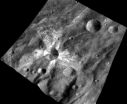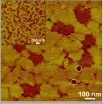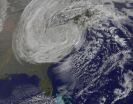(Press-News.org) Using cutting-edge virtual reality technology, researchers have 'beamed' a person into a rat facility allowing the rat and human to interact with each other on the same scale.
Published today in PLOS ONE, the research enables the rat to interact with a rat-sized robot controlled by a human participant in a different location. At the same time, the human participant (who is in a virtual environment) interacts with a human-sized avatar that is controlled by the movements of the distant rat. The authors hope the new technology will be used to study animal behaviour in a completely new way.
Computer scientists at UCL and the University of Barcelona have been working on the idea of 'beaming' for some time now, having last year digitally beamed a scientist in Barcelona to London to be interviewed by a journalist.
The researchers define 'beaming' as digitally transporting a representation of yourself to a distant place, where you can interact with the people there as if you were there. This is achieved through a combination of virtual reality and teleoperator systems. The visitor to the remote place (the destination) is represented there ideally by a physical robot.
During the human-animal beaming process the human participants in the system were in a virtual reality lab at the Mundet campus of the University of Barcelona. The rat was located around 12 km away in an animal care facility in Bellvitge.
Tracking technology was used to track the movements of the rat in its arena, and the tracking data was transmitted over the internet to the computers running the virtual reality simulation in Mundet. This tracking information was used to control a virtual human character (an avatar) that represented the rat so that whenever the rat moved its avatar moved too, in a representation of the rat arena but scaled up to human size. Hence the human participant shared the virtual arena, which looked like a room with some pictures on the walls, with a humanoid avatar.
The movements of the human in the virtual reality were also tracked, and the data sent to computers in Bellvitge that controlled a small robot that was located in the rat arena. Whenever the human moved in the virtual space the robot moved in the rat space.
Putting all this together - the rat interacted with a rat sized robot that represented the remotely located human, and the human interacted with a human sized avatar that represented the remotely located rat.
Professor Mandayam Srinivasan, author of the paper from the UCL Department of Computer Science and MIT, said: "Beaming is a step beyond approaches such as video conferencing which do not give participants the physical sensation of being in the same shared space, and certainly not the physical capability to actually carry out actions in that space."
He added: "The process demonstrated here not only shows the range of our technology, but also provides a new tool for scientists, explorers or others to visit distant and alien places without themselves being placed in any kind of danger, and importantly, to be able to see animal behaviour in a totally new way - as if it were the behaviour of humans."
Professor Mel Slater, also from the UCL Department of Computer Science and also ICREA, University of Barcelona said: "In the paper we used the idea of representing the rat as if it were a human, but there would be many other possibilities. One idea is that using this technology behavioural scientists could get insights into behaviour by observing it, and taking part in it, through this quite different filter. However, our primary goal was to demonstrate the possibilities inherent in this technology."
###
Notes to Editors
1. For more information or to interview Professor Mandayam Srinivasan or Professor Mel Slater, please contact Clare Ryan in the UCL Media Relations Office on tel: +44 (0)20 3108 3846, mobile: +44 07747 565 056, out of hours +44 (0)7917 271 364, e-mail: clare.ryan@ucl.ac.uk.
2. 'Beaming into the Rat World: Enabling Real-Time Interaction Between Rat and Human Each at Their Own Scale' is published in PLOS ONE and will be available from this link once the embargo has lifted: http://dx.plos.org/10.1371/journal.pone.0048331
3. Journalists can also obtain copies of the paper by contacting UCL Media Relations.
4. Video footage and stills from the experiment are available to journalists on request from UCL Media Relations.
Virtual reality 'beaming' technology transforms human-animal interaction
2012-11-01
ELSE PRESS RELEASES FROM THIS DATE:
Global genome effort seeks genetic roots of disease
2012-11-01
By decoding the genomes of more than 1,000 people whose homelands stretch from Africa and Asia to Europe and the Americas, scientists have compiled the largest and most detailed catalog yet of human genetic variation. The massive resource will help medical researchers find the genetic roots of rare and common diseases in populations worldwide.
The 1000 Genomes Project involved some 200 scientists at Washington University School of Medicine in St. Louis and other institutions. Results detailing the DNA variations of individuals from 14 ethnic groups are published Oct. ...
Medical schools fall short on teaching students about obesity
2012-11-01
WINSTON-SALEM, N.C. – Oct. 31, 2012 -- It's no secret that obesity is a major problem in America.
More than one-third of adults and one-sixth of children are obese and it is one of the leading causes of preventable death. The costs associated with obesity are estimated at $99 million annually, comparable to the economic toll of cigarette smoking.
Despite all this, few U.S. medical schools are providing adequate, effective training on how to address weight issues in obese patients, according to researchers at Wake Forest Baptist Medical Center.
"Medical students are surrounded ...
New type of 'space weathering' observed on asteroid Vesta
2012-11-01
PROVIDENCE, R.I. [Brown University] — The surface of the giant asteroid Vesta is weathering in a way that appears to be completely different from any other asteroid yet visited, according to new data recorded by NASA's Dawn spacecraft. This new type of space weathering suggests that there's something about Vesta — perhaps its mineral composition or its position in the solar system — that makes its surface environment fundamentally different from other asteroids studied thus far.
The new data are presented in a paper published Nov. 1, 2012, in the journal Nature.
Space ...
Taming mavericks: Stanford researchers use synthetic magnetism to control light
2012-11-01
Magnetically speaking, photons are the mavericks of the engineering world. Lacking electrical charge, they are free to run even in the most intense magnetic fields. But all that may soon change. In a paper published in Nature Photonics, an interdisciplinary team from Stanford University reports that it has created a device that tames the flow of photons with synthetic magnetism.
The process breaks a key law of physics known as the time-reversal symmetry of light and could yield an entirely new class of devices that use light instead of electricity for applications ranging ...
OHSU researchers discover potential way to repair brain damage in multiple sclerosis
2012-11-01
PORTLAND, Ore. — Researchers at Oregon Health & Science University have discovered that blocking a certain enzyme in the brain can help repair the brain damage associated with multiple sclerosis and a range of other neurological disorders.
The discovery could have major implications for multiple sclerosis, complications from premature birth and other disorders and diseases caused by demyelination – a process where the insulation-like sheath surrounding nerve cells in the brain becomes damaged or destroyed. Demyelination disrupts the ability of nerve cells to communicate ...
Spot the difference
2012-11-01
The 1000 Genomes Project today presents a map of normal human genetic variation – everything from tiny changes in the genetic code to major alterations in our chromosomes. In a DNA version of 'spot-the-difference', EMBL scientists and their colleagues studied the genomes of 1092 healthy people from Europe, the Americas and East Asia, systematically tracking what makes us different from each other. Their results, published in Nature, open new approaches for research on the genetic causes of disease.
"The 1000 Genomes Project has achieved something truly exceptional in ...
New study shows effects of prehistoric nocturnal life on mammalian vision
2012-11-01
AUSTIN, Texas — Since the age of dinosaurs, most species of day-active mammals have retained the imprint of nocturnal life in their eye structures. Humans and other anthropoid primates, such as monkeys and apes, are the only groups that deviate from this pattern, according to a new study from The University of Texas at Austin and Midwestern University.
The findings, published in a forthcoming issue of Proceedings of the Royal Society B, are the first to provide a large-scale body of evidence for the "nocturnal bottleneck theory," which suggests that mammalian sensory ...
Jamaican teen immigrants do better when they retain strong ties to original culture
2012-11-01
URBANA –Many young Jamaican immigrants are succeeding in the United States precisely because they remain strongly tied to Jamaican culture, said University of Illinois professor Gail M. Ferguson.
"Although many of these youths have forged a unique tricultural identity that draws from their Jamaican culture, African-American culture, and mainstream European American culture, the important factor in their academic and behavioral success is retaining strong ties to their Jamaican background," she said.
To learn how Jamaican immigrant teens were adjusting to life in their ...
Folding funnels key to biomimicry
2012-11-01
Proteins are able to self-assemble into a wide range of highly ordered structures that feature a diverse array of properties. Through biomimicry - technological innovation inspired by nature – humans hope to emulate proteins and produce our own version of self-assembling molecules. A key to accomplishing this is understanding how protein-folding – a process critical to the form and function of a protein – is extended from individual proteins to complex assemblies.
Researchers with the U.S. Department of Energy (DOE)'s Lawrence Berkeley National Laboratory (Berkeley Lab) ...
Satellite captures the life and death of Hurricane Sandy on Halloween
2012-11-01
VIDEO:
This animation of satellite imagery shows the life of Hurricane Sandy from its development in the Caribbean Sea on Oct. 21, through its track up the US East coast and...
Click here for more information.
Hurricane Sandy is giving up the ghost on Halloween over Penn. As the storm weakened to a remnant low pressure area the NASA GOES Project released an animation of NOAA's GOES-13 satellite imagery covering Hurricane Sandy's entire life.
The GOES-13 satellite is managed ...




